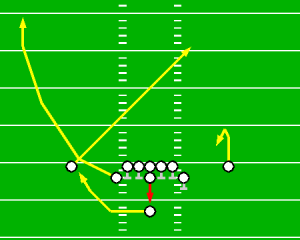Description
If you need to pass but the defense you're facing is doubling up on your best receivers, Scythe is a great play for opening things up for you tight end and running back. While the slant run by the left split end is the primary read, as well as the best option for a deep throw downfield, maybe the best feature of the play are the double swing style routes run by the left tight end and the running back. Cutting under the SE slant route, this route pair may overwhelm the defense momentarily, usually forcing the defender to cover the deeper TE and leaving the RB uncovered. Throw the swing to the RB and he may be able to follow the TE's blocking in front for a long gain.

You should have decent time to check down through these options, set the quarterback's feet and make a sure throw because the #1 TE on the right side stays in to pass protect. Finally, if nothing opens up on the left side of the field the right SE runs a simple 4 yard curl route. This usually gets open easily because the mid-field defenders are forced to chase the other TE and RB to the other side.
One thing I really like about Scythe, and I think you will too, is that it works against almost every defense that might be expected against it. With two receivers and two tight ends, a 4-3 or 3-4 is the likely opposition on most downs, with a Nickel possible on later downs. I tested several defenses in 4-3 and Nickel packages, and the only one I found that really caused a problem was the 4-3 Cover 2 Zone. The linebackers dropping into pass coverage took away the slant both early and later over the middle, while the ROLB and corner both covering areas rather than individuals were pretty effective at stopping the double swing. The LOLB and cornerback covered the curl effectively. Still, even against this defense the QB has a lot of time in the pocket and may be able to find the TE late in the deep corner, or can buy some time with his feet to let the curl receiver move to a soft spot in the zone. No Nickel defense and no other 4-3 was very effective. Blitzes can be attacked by the quick slant over the middle or the RB swing, while man coverages are simply over-matched by the receiver overload.
Player Assignments
| Position | Action |
|---|---|
| O-Line | Pass Block |
| QB | Dropback 2yd |
| Left SE | N6E6 (open) |
| Left TE | N1W2-N2W2-N3W1-N3 (open) |
| Right TE | Pass Block |
| Right SE | 4yd Curl |
| RB | Swing Left |
See the Madden Playbook Guide for a description of these symbols.
Read Progression
- Left SE slant (quick)
- TE swing
- RB swing
- Right SE curl
- Left SE slant (late over deep middle)
Against a blitz or soft zone the SE is a good throw immediately after the snap. Next, look for the TE and RB swing combo. The TE is your first look between the two. This throw should usually be made a bit wide and short to keep it away from defenders. More often the RB is the better choice, throw this like any standard swing, and look for the TE to throw a block after the catch. If nothing on the left is open look back to the right, where the SE should be just finishing his curl. Finally, look back to the slant route over the deep middle. The best defense to make this pass against is usually a Cover 2 where the linebackers are blitzing or in man coverage so they don't get in the passing lane. Throw to hit the receiver over the middle, between and just under the safeties.
Analysis
Pros:
- Works against almost all 4-3 and Nickel defenses
- Left TE often opens up RB swing pass while getting in position to throw a block downfield, creating great YAC potential
- Blocking TE allows time for play to develop, as well as let the QB roll right and let the right SE get open if things break down
Cons:
- TE swing can be a dangerous throw, especially against zones, because he's right in the middle of traffic
- Tempting to throw the slant late over the middle, but dangerous with MLB in coverage
Contact Arkaein with any comments or questions regarding the Monstrous Madden Playbook.